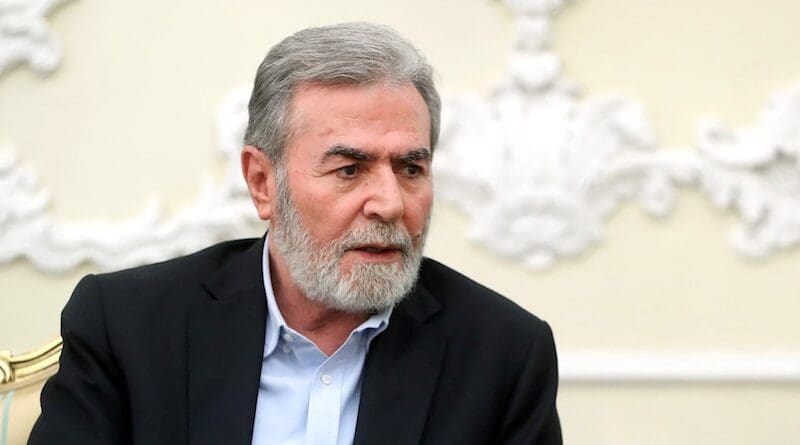Israel And Hamas Grapple With Egyptian Gaza Roadmap – Analysis

The secretary-general of the Palestinian Islamic Jihad Movement, Ziyad al-Nakhalah. Photo: Iranian Presidency Office
Ziyad al-Nakhalah, the leader of Palestine Islamic Jihad, the second most significant militant Gazan group, arrived in Cairo this week for carefully timed talks with Egyptian intelligence chief General Abbas Kamel.
A Palestinian source said Mr. Al-Nakhalah was discussing an end to the Gaza war that would involve an exchange of prisoners, the withdrawal of Israeli forces, and reconstruction of the devastated territory.
On the table was a three-stage Egyptian proposal that falls short of mutually exclusive Israeli and Palestinian demands.
Hamas used the plan to increase pressure on Israeli Prime Minister Binyamin Netanyahu to prioritise the release of the remaining 107 living hostages kidnapped by the group during its October 7 attack on Israel and 22 bodies of killed captives rather than prosecution of the war.
Even so, finding common ground between Israel, bent on destroying Hamas at any cost and refusing to contemplate an end to the Gaza war, and Hamas’ refusal to negotiate further prisoner exchanges without Israel agreeing to a permanent ceasefire and withdrawal from Gaza amounts to a Herculean, if not impossible task.
More than 20,000 people, mostly innocent civilians, have been killed in Israel’s ten-week-old air and ground assault on Gaza.
The Egyptian proposal seeks to maneuver the minefields by proposing the exchange of all remaining Hamas hostages for all Palestinians held in Israeli prisons, estimated at more than 7,000, in three phases over a period of up to two months during which both parties would hold their fire.
The proposal would allow Hamas to drop its demand for a permanent ceasefire as a pre-condition for prisoner exchanges.
Speaking to Al Jazeera, Beirut-based Hamas political bureau member Osama Hamdan said the Egyptian plan was “still ideas” rather than a formal proposal.
“We are not yet talking about a solid proposal,” Mr. Hamdan said.
Israeli war cabinet member Benny Gantz told hostage families that “there are Egyptian proposals and there are other proposals flying around from all kinds of directions. I don’t even know which of them are even relevant.”
The Egyptian proposal envisions Israeli withdrawals from Gaza during the period of exchanges that would force Israel, should hostilities revive, to adopt less devasting, more limited and targeted military operations in line with American demands.
On the assumption that Israel’s goal of destroying Hamas is unrealistic, the plan further envisions Egyptian and Qatar-mediated reconciliation talks between Hamas and its archival, Palestinian President Mahmoud Abbas’s West Bank-based Al-Fatah movement.
An inter-Palestinian agreement would open the door for Hamas to be part of the Palestinian administration of Gaza and the West Bank and join the Palestine Liberation Organisation (PLO), a Palestinian umbrella group.
Seemingly responding to efforts to reconcile Hamas and Al-Fatah, Mr. Netanyahu, writing in The Wall Street Journal added deradicalization of Palestinian society to his war aims.
“Hamas must be destroyed, Gaza must be demilitarized, and Palestinian society must be deradicalized. These are the three prerequisites for peace between Israel and its Palestinian neighbors in Gaza… Palestinian civil society needs to be transformed so that its people support fighting terrorism rather than funding it,” Mr. Netanyahu said.
The Egyptian plan envisions the creation of a technocratic Palestinian government that would take office in stage three. The government would prepare the ground for long-overdue presidential and parliamentary elections in which Hamas would compete.
“Who will decide the temporary leadership? Who will nominate these people? We have always said the Palestinian people must elect their own leadership,” said Mr. Hamdan, the Beirut Hamas spokesman.
That’s where the importance kicks in of the Cairo visit of Mr. Al-Nakhalah, whose Islamic Jihad group focuses on armed struggle against Israel, and not on the day after the war or contours of a future Palestinian polity or Palestinian state.
The visit buys time for exiled Hamas officials to try to bridge differences with the group’s Gaza leadership.
Some of the exiled officials favour a reconciliation with Al-Fatah that would entail some form of implicit or explicit recognition of Israel while the Gaza leadership rejects concessions.
“What needs to happen is to expand the PLO in order to include in its ranks all Palestinian factions…especially Hamas (and) Islamic Jihad,… The Palestinian position is best presented to the world by a united Palestinian polity…. There is no other solution to the current impasse,” said former Palestinian prime minister Salam Fayyad.
If the exile officials prove successful, and that is if with a capital I, they could spark a paradigm shift in the dynamics of the Gaza war and the Israeli-Palestinian conflict much like the PLO’s recognition of Israel and disavowal of violence did in the 1980s.
Hamas has so far rejected the PLO template. It argues that the template failed to produce an independent Palestinian state and contributed to a weakening of the Palestinians since the 1993 signing of the Oslo accords.
The shift in Hamas’ position advocated by the exiles would complicate life for Israeli Prime Minister Binyamin Netanyahu for whom acceptance of a role for Hamas in post-war Palestine would likely put the last nail in his political coffin.
It would also put on the spot the Biden administration that supports Mr. Netanyahu’s goal of destroying Hamas at any cost.
In contrast to Israel, the United States wants to see a capable and effective Palestine Authority govern both the West Bank and Gaza.
As a result, Palestinian reconciliation could force the United States to exert the kind of pressure on Israel it has so far refrained from applying.
So far, US coaxing has not only failed to persuade Israel to change its military tactics to reduce innocent Palestinian casualties.
Israel has also stymied the Biden administration’s efforts to make the discredited and cash-starved Palestine Authority viable and more fit for purpose by refusing to release US$140 million in Palestinian tax money frozen since October 7 so that the Authority can pay salaries.
A second proposal to end the Gaza war, reportedly drafted by Abdelaziz al-Sagher, head of the Saudi-backed Gulf Research Council, and Anne Grillo, head of the French foreign ministry’s North Africa and Middle East Department, called for the creation of a “joint transition council” to govern the territory for four years.
The council, operating under the auspices of a United Nations-mandated Arab peacekeeping force, would include Hamas and Islamic Jihad.
Paradoxally, the plan, which was likely to be even less palatable to Israel, threw Mr. Netanyahu a bone by suggesting that Hamas political and military leaders, whether in exile or Gaza, be shipped off to Algeria.
The Egyptian plan calls for a first phase during which Hamas and Israel, much like in November, would exchange 40 hostages – women, children, and the elderly — for 120 Palestinians during a seven-to-10-day truce that would also allow for the less fettered entry of humanitarian aid into Gaza.
Last month, Israel released 240 Palestinians for more than 100 hostages, mainly women and children, during a one-week truce.
In the second seven-day phase Hamas would release captive Israeli women soldiers and the bodies of Israelis killed since October 7.
That’s where the problems start given that the established ratio for the exchange of Israeli military personnel is far higher than the 1 Israeli for 3 Palestinians applied to civilian women and children.
In 2011, Hamas freed Israeli soldier Gilad Shalit in exchange for 1,027 Palestinians. In 1984 Israel exchanged 4,500 Palestinians for six Israelis held in Lebanon by the Palestine Liberation Organisation (PLO) and two years later 1,150 for three Israelis captured by the Popular Front for the Liberation of Palestine-General Command.
The third month-long phase of Egypt’s plan would see the release of the remaining hostages, primarily Israeli military personnel, in exchange for all Palestinians still in Israeli prisons, including those convicted to long prison or life sentences for killing Israelis.
Their release could spark the breakup of Mr. Netanyahu’s coalition government whose ultra-nationalist, ultra-conservative elements reject major concessions.
Blamed by a majority of Israelis for Israeli intelligence and operational failures that enabled Hamas’ October 7 attack in which more than 1,000 in majority civilians were killed, Mr. Netanyahu can ill-afford a political crisis.
“Potentially, Egypt’s proposal, if adopted, would constitute a victory for Hamas. If Hamas plays its card well, it could corner Netanyahu,” said an Arab diplomat.

Dr. James M. Dorsey is an award-winning journalist and scholar, a Senior Fellow at the National University of Singapore's Middle East Institute and Adjunct Senior Fellow at Nanyang Technological University's S. Rajaratnam School of International Studies, and the author of the syndicated column and blog.
No comments:
Post a Comment